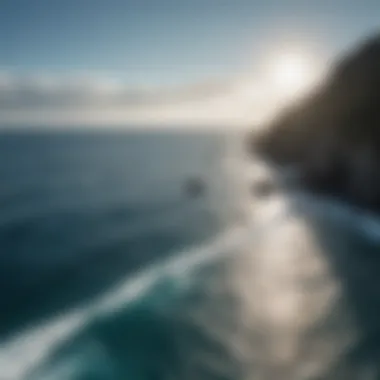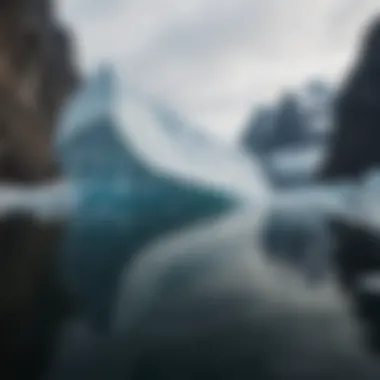Exploring the Earth's Four Major Oceans: An Overview


Intro
The world's oceans are not just vast stretches of water; they are intricate systems teeming with life, sustenance, and beauty. From the expansive Pacific to the frigid Arctic, each ocean possesses its own unique characteristics that shape our climate, support diverse marine ecosystems, and influence human culture and economies. This article explores these four key oceans in depth, revealing their wonders and challenges.
As we embark on this journey, one must appreciate the relevance of the oceans in our daily lives. They are significant players in the global economy, providing fisheries that feed millions, shipping routes that connect continents, and even recreational opportunities that bring joy to adventure seekers. However, these waters also face pressing threats from pollution, climate change, and overfishing, making it imperative that we understand and advocate for their preservation.
In this exploration, we will address the physical geology of each ocean, the marine life that calls them home, and the impact they have on human civilization. By blending hard facts with observable phenomena, we aim to give a comprehensive overview of the four oceans—Pacific, Atlantic, Indian, and Arctic—while inviting readers to reflect on their relationship with these majestic waters.
"The sea, once it casts its spell, holds one in its net of wonder forever." — Jacques Cousteau
Moving forward, we will dive into the fundamental techniques and skills that enthusiasts and adventurers should develop when engaging with our oceans. Building a solid foundation in these areas not only enhances personal skills but also fosters a deeper connection with the marine world.
Preface to the Four Oceans
When we talk about the natural wonders of our planet, the oceans stand as monumental bodies that not only shape the Earth’s geography but also influence climate, weather patterns, and biodiversity. The exploration of the four major oceans—the Pacific, Atlantic, Indian, and Arctic—serves a crucial role in understanding our world and, increasingly, our impact on it.
Defining Oceans
Oceans, in their broadest sense, are vast expanses of saltwater that separate continents and islands. Each of the four oceans possesses its own character:
- Pacific Ocean – The largest and deepest, cradling numerous islands and its unique marine ecosystems.
- Atlantic Ocean – Known for its significant historical trade routes and the connections it forges between the continents.
- Indian Ocean – A key player in global transport, rich in culture and diverse in its marine life.
- Arctic Ocean – Often misunderstood, this ocean is critical not only for its unique environment but for its burgeoning role in climate change discussions.
These definitions lay the groundwork for understanding not only their distinctiveness but also their interconnectedness.
Importance of Oceans to Earth
The oceans are integral to life on Earth, acting as the lungs of our planet by producing over half the oxygen we breathe. Additionally, they:
- Regulate Climate: Oceans act as a buffer against climate extremes, absorbing heat and redistributing it globally.
- Support Biodiversity: Housing thousands of unique species, oceans are crucial for maintaining ecological balance.
- Provide Resources: Beyond their rich fishing stocks, oceans offer potential resources like energy from tidal and wave actions.
- Facilitate Trade: More than 80% of global trade by volume moves through oceans, fundamentally shaping economies worldwide.
Understanding the significance of oceans enhances our awareness around pressing environmental issues, such as pollution and climate change.
As we dive deeper into each ocean's unique attributes and the challenges they face, we recognize the essential role they play in our ecosystem and the pressing need for their preservation.
The Pacific Ocean
The Pacific Ocean, with its vastness and depth, is not just the largest ocean on our planet; it plays a crucial role in shaping our world both ecologically and culturally. Covering about one-third of Earth’s surface, this ocean is a treasure trove of marine biodiversity and serves as a significant channel for global commerce and cultural exchange. From water sports to scientific exploration, its value extends beyond mere metrics.
Geographical Extent
The geographical stretch of the Pacific Ocean is unmatched, sprawling approximately 63 million square miles. It extends from the Arctic Ocean in the north down to the Southern Ocean, bordering Asia and Australia on the west and east. Within its deep embrace lie countless islands, such as the scattered beauties of Hawaii and the myriad atolls of Micronesia. Each region varies greatly in topography, from towering volcanic peaks to tranquil sandy shores.
Navigating through the Pacific is not just about the distances but understanding its intricate network of currents and tides that connect distant coastal communities. The Great Pacific Garbage Patch, a poignant reminder of human impact, shows the ocean's ability to gather debris, which affects ecosystems. This calls attention to the challenges of managing an area so large, demonstrating that each corner of the Pacific is a thread in the fabric of global health.
Ecological Diversity
Ecological diversity within the Pacific is staggering, making it a dreamland for marine biologists and ocean enthusiasts. Home to the Great Barrier Reef, it hosts thousands of species, including colorful coral, diverse fish populations, and unique marine mammals like the endangered right whale. The various habitats—from kelp forests to deep ocean trenches—provide distinct ecosystems that support life at different levels.
Research shows that biodiversity in this ocean not only impacts the health of marine life but also contributes to global oxygen production and carbon sequestration. These elements critically influence climate stability, highlighting the interconnectedness of life. The diversity also shows that local fishing practices are essential, bringing to light the balance needed between human activity and conservation efforts.
Cultural Significance
The cultural significance of the Pacific Ocean is profound. For centuries, it has served as a bridge connecting diverse communities, influencing indigenous cultures around its shores. From Polynesian navigation techniques to traditional fishing practices, the humans of the Pacific have developed unique connections with the ocean that shaped their identities and economies.
Events like the annual canoe races in Hawaii exemplify the living culture still linked to the ocean. These activities are not just competitions; they reflect a deep respect for the sea, its resources, and the shared heritage of the communities surrounding it. Furthermore, the Pacific is a vital trade route, facilitating the exchange of goods and ideas—strengthening its cultural dimensions.
"The ocean stirs the heart, inspires the imagination, and brings eternal joy to the soul."
- Wyland
In understanding the Pacific Ocean, one recognizes it as a complex entity—an interwoven tale of geography, ecology, and humanity that continues to influence life on Earth. To keep unraveling this narrative, it’s essential to explore each aspect further, appreciating the ocean's role in our global narrative.
The Atlantic Ocean
The Atlantic Ocean stands as a remarkable body of water, stretching from the icy shores of the Arctic in the north all the way down to the warm Caribbean waters in the south. It serves not just as a divider of continents but as a bridge connecting cultures, economies, and ecosystems. This ocean is of paramount importance in the navigation routes that have shaped global trade and exploration. With its rich history, extensive marine biodiversity, and significant role in climatic patterns, the Atlantic Ocean deserves thorough examination.


Geographical Features
The Atlantic is the second largest ocean, covering approximately 41 million square miles. This vast ocean is bordered by North America to the west and Europe and Africa to the east. Tightening like a shoe string at the mid-Atlantic ridge, it reveals a fascinating series of mountain ranges under its surface. Noteworthy geographical landmarks within the Atlantic include the Bermuda Triangle, known for its mysterious disappearances, and the Azores, an archipelago that sits atop volcanic activity and presents breathtaking landscapes.
Various deep-sea trenches, like the Puerto Rico Trench and the Dominican Republic Trench, plunge dramatically into the depths, creating underwater abyss known for their uniqueness. While much remains unexplored, these features not only affect oceanic currents but also house unique species and ecosystems.
Marine Ecosystems
The Atlantic Ocean boasts an array of marine ecosystems, each brimming with life. Ranging from coral reefs to frigid northern waters, the biodiversity is astounding.
- Coral Reefs: Found near the Caribbean and southeastern United States, these vibrant ecosystems provide habitat for numerous species of fish and other marine organisms.
- Seagrass Meadows: Critical for carbon sequestration, these meadows provide both breeding and nursery grounds for fish, along with acting as natural filtration systems.
- Upwelling Zones: These areas bring nutrient-rich waters to the surface, supporting rich fisheries and significant marine life. The coasts of West Africa and the eastern United States highlight these phenomena.
Migrations of species such as humpback whales and sea turtles also showcase the interconnectedness of ocean life, drawing attention to the need for sustainable practices.
Impact on Global Trade
The Atlantic has been a channel of trade since ancient times. Its vastness enables countries to exchange goods at unprecedented scales. Major shipping lanes crisscross this ocean, linking the Americas with Europe and Africa. The Port of Rotterdam in the Netherlands and the Port of New York and New Jersey are often regarded as vital trade hubs.
Economic benefits from the Atlantic include:
- Fishing Industry: The Atlantic's rich fishing grounds support a multimillion-dollar industry.
- Oil and Gas: Offshore drilling in places like the North Sea has provided resources crucial for energy consumption.
- Tourism: Coastal cities and islands see millions of tourists each year, bolstering local economies.
"The Atlantic Ocean is not just a body of water; it is a life source, a trade route, and a cultural bridge."
Its influence isn't merely economic – it extends to cultural exchanges, embedding itself into the histories of nations that border it. The fateful voyage of Christopher Columbus or the bustling activity of the transatlantic slave trade are just snippets of the stories tied to this ocean, highlighting its complex and sometimes tumultuous history. Each tide and wave not only carries marine life but also the echoes of human endeavors and dreams.
The Indian Ocean
The Indian Ocean holds a unique and pivotal place among the world's oceans. It doesn't just cover a vast stretch of water; it serves as a critical nexus for trade, cultural exchanges, and biodiversity. Separated from the other oceans by the great continent of Africa, the formidable mountains of the Himalayas, and the archipelagos of Southeast Asia, the Indian Ocean is a site of significant natural beauty and resource diversity. For water sports enthusiasts and outdoor adventurers, this ocean is a playground that boasts some of the most stunning coastlines and vibrant marine environments on the planet.
Key Characteristics
One of the defining traits of the Indian Ocean is its size; it is the third-largest ocean covering about 20% of the Earth’s water surface. The ocean is framed by several key geographical landmarks, including the African coast on the west, the Asian mainland to the north, and Australia to the east. What sets this ocean apart is not just its location but also its depth; the Java Trench is the deepest point within the Indian Ocean, plunging down 7,725 meters.
Distinctive currents, like the Agulhas Current, which flows southward along the eastern coast of Africa, play an important role in global ocean circulation and weather patterns. These currents have a significant impact on temperatures, marine life distribution, and even the climate of coastal countries.
In terms of challenges, the Indian Ocean is no stranger to extreme weather events such as cyclones, especially during the monsoon season. Such climatic shifts affect not only the marine ecosystem but also the livelihoods of coastal communities. Understanding these characteristics is essential for anyone interested in the dynamics of water sports in the region, as they directly influence tide patterns and activity suitability.
Biodiversity Hotspots
The Indian Ocean is teeming with life. It houses several critical biodiversity hotspots, which are areas rich in species and endemism that are also under threat from human activities. One standout example is the Coral Triangle, located in the eastern part of the ocean near Indonesia, which is renowned for its incredible variety of coral reefs and marine species. It's often described as the "Amazon of the seas" due to its wealth of life.
The Indian Ocean also hosts unique species such as the dugong, which grazes on seagrass meadows, and a myriad of fish species that are vital for local fishing communities. Additionally, the ocean's ecosystems play a significant role in carbon capture, helping to mitigate climate change.
Efforts are being made to preserve these hotspots, as many of them are threatened by overfishing, pollution, and climate change. For adventurers seeking to experience unusual marine environments, these hotspots offer an unrivaled opportunity to engage with nature.
Cultural Exchanges and Trade
Historically, the Indian Ocean has been a conduit for cultural exchanges and trade for centuries. Spice routes established during ancient times forged connections between the East and West, facilitating the transfer of not only goods but ideas and cultures. The maritime trade networks that arose due to this ocean shaped the cultural landscape of several nations, intertwining their destinies.
Modern maritime trade remains pivotal. Ports such as Mumbai, Durban, and Colombo are not just busy trading hubs; they're melting pots of culture and diversity. The Indian Ocean also supports essential industries including fishing, shipping, and tourism, which contribute substantially to the economies of surrounding nations.
However, it’s important to note that the ocean is more than a trade route; it’s a living gallery of cultural heritage. Engaging with the local cultures offers outdoor enthusiasts unique insights into the regions they explore, emphasizing the importance of preserving these traditions.
By appreciating the historical, ecological, and economic significance of the Indian Ocean, we can foster a deeper connection with this vital body of water, ensuring its health for generations to come.
Navigating the complexities of the Indian Ocean can be an enlightening journey. Its characteristics, biodiversity, and cultural dimensions capture the essence of why this ocean is cherished by adventurers and scholars alike.
The Arctic Ocean
The Arctic Ocean is often an overlooked giant among the world's oceans, yet it holds a treasure trove of unique features that set it apart. Understanding the Arctic Ocean is crucial; not just for its natural wonders, but also for the role it plays in the larger narrative of Earth's interconnected water bodies. This ocean harbors a distinct environment, faces formidable climate challenges, and is home to Indigenous cultures that have thrived for millennia.
The Unique Environment
Unlike its warmer counterparts, the Arctic Ocean is characterized by its frigid temperatures and distinctive ice-covered waters. This ocean is the smallest of the four the world’s major oceans, yet it boasts a myriad of ecological wonders. The surface is often enveloped in sea ice, which serves as a habitat for species such as polar bears and seals.


Moreover, the Arctic is home to a unique biological community. Beneath the ice, organisms like phytoplankton flourish, developing in the short summer months when sunlight penetrates the ice. This primary production forms the foundation for an intricate food web, supporting species ranging from small fish to the massive blue whale.
Additionally, the Arctic Ocean is home to the Trans Polar Drift, a powerful ocean current that transports water from Siberian seas to the Greenland Sea. This unique feature plays a significant role in regulating global climate patterns and highlights the ocean's connectivity to other bodies of water.
Climate Change Challenges
The Arctic Ocean is on the frontlines of climate change, facing some of the most profound impacts of rising global temperatures. The region has experienced dramatic warming, leading to unprecedented ice melt during summers. The shrinking ice not only endangers local wildlife but also disrupts traditional patterns of food availability for Indigenous peoples.
According to recent studies, Arctic sea ice has diminished by more than 70% since the late 1970s, which raises alarms about global sea levels. This alteration in ice coverage affects salinity levels and subsequently the migration patterns of marine species. Furthermore, the influx of warmer waters could allow for invasive species that threaten native fauna and flora, ultimately disrupting the entire ecosystem of the Arctic region.
"The reality of climate change in the Arctic is not just a distant concern; it is a present-day challenge affecting lives, habitats, and global weather patterns."
Indigenous Cultures
The Arctic Ocean is, and has historically been, vital to numerous Indigenous cultures. Groups such as the Inuit and Saami have adapted their lifestyles around the rhythms of the Arctic seas. Their traditional knowledge offers invaluable insights into sustainable resource management and environmental conservation.
Fishing, hunting, and gathering are traditional practices that have sustained these cultures for generations.
- Traditional Fishing Methods: Utilizing nets and traps made of local materials, Indigenous peoples have developed techniques that respect the balance of marine life.
- Hunting Practices: For instance, the hunt for seals not only provides food but plays a vital role in cultural rituals and gatherings.
- Gathering Practices: Gathering berries and other coastal vegetation contributes to food security in the harsh climate.
The connection between these communities and the ocean runs deep. It is not merely a resource; it is intertwined with their identities, languages, and spiritual beliefs. Unfortunately, climate change is threatening their ways of life, underscoring the need for effective policies that recognize both their rights and the necessity of protecting the Arctic Ocean.
The Interconnectedness of Oceans
The oceans are not isolated bodies of water. Instead, they form a vast and intricate network that interacts in ways that profoundly influence our planet. Understanding the interconnectedness of oceans reveals how these waterways regulate global climate, foster diverse ecosystems, and impact weather patterns. This section delves into two primary aspects of this interconnectedness: ocean currents and climate regulation, and their influence on weather patterns.
Ocean Currents and Climate Regulation
Ocean currents can be seen as the blood vessels of our planet, continuously transporting warm and cold water across vast distances. These currents play a critical role in maintaining the Earth's climate. For example, the Gulf Stream, which originates in the Gulf of Mexico, carries warm water up the eastern coast of North America and across the Atlantic to Western Europe. This warm water significantly moderates climates, preventing harsh winters in Europe that would otherwise occur at such latitudes.
Ocean currents also regulate the carbon cycle. The surface waters absorb carbon dioxide from the atmosphere, and through deep-sea currents, this carbon is transported to the ocean floor, where it can remain sequestered for centuries. This process helps mitigate climate change impacts, illustrating the essential role of oceans in maintaining ecological balance. A few critical aspects of ocean currents include:
- Heat Distribution: They circulate heat, contributing to temperature regulation globally.
- Nutrient Transport: Currents facilitate the movement of nutrients vital for marine life.
- Climate Stability: By influencing weather and climate patterns, they help stabilize ecosystems.
"Ocean currents are like the Earth's veins, throbbing with energy and life, and nourishing everything in their path."
Impact on Weather Patterns
The oceans exert a profound influence on global weather patterns. The presence of vast bodies of water acts as a regulatory mechanism for temperature and precipitation. For instance, regions near oceans tend to have milder climates compared to inland areas. This can be attributed to the water’s ability to absorb and release heat more slowly than land.
El Niño and La Niña events are examples of the direct impact of oceanic changes on weather patterns. During an El Niño event, warmer waters in the Pacific Ocean disrupt traditional weather patterns, leading to increased rainfall in some regions and droughts in others. Conversely, La Niña tends to strengthen the trade winds and usually causes cooler ocean temperatures, leading to opposite weather anomalies.
Some key points of how oceans affect weather patterns are:
- Storm Formation: Warm ocean temperatures can fuel hurricanes and tropical storms.
- Precipitation Patterns: Ocean temperatures greatly influence rain distribution across continents.
- Temperature Regulation: Coastal regions enjoy temperate climates due to oceanic influences.
In summary, understanding the interconnectedness of oceans equips us with knowledge about their crucial functions in regulating climate and weather. Recognizing this symbiotic relationship not only enhances our appreciation of marine environments but also encourages responsible stewardship over these vital resources.
Human Impact on the Oceans
Understanding human impact on the oceans is fundamental to grasping the delicate balance between our activities and marine ecosystems. The oceans cover more than 70% of the Earth’s surface, acting as a critical refuge for countless species while also playing a vital role in weather regulation and oxygen production. However, our relentless pursuit of economic growth and resource exploitation often leads to severe consequences for these vast water bodies. This section will delve into the primary ways humans are reshaping the oceans, focusing on pollution, overfishing, and the overarching effects of climate change.
Pollution and Its Effects
Pollution enters the oceans through various pathways, from rivers carrying industrial waste to plastic debris littering shorelines. It's a grim reality that marine litter, especially plastics, has turned many coastal areas into dumping grounds. The harmful impacts are not just on marine life; chemicals introduced into the water can bioaccumulate in fish, eventually making their way into human diets. A stark example is the Great Pacific Garbage Patch, where an estimated 1.8 trillion pieces of plastic float, threatening marine biodiversity.
- Chemical Pollutants: Heavy metals and toxins like mercury from industrial runoff can have devastating impacts on marine organisms.
- Nutrient Runoff: Fertilizers entering waterways can cause algal blooms, leading to hypoxia or dead zones where life cannot thrive.
- Microplastics: These tiny plastic particles have been found in the deepest ocean trenches, indicating that pollution is a pervasive issue.
"The ocean is not a landfill; it is a living ecosystem that sustains us all."
Addressing pollution is not just an environmental issue; it's a moral one. Commitments must be made to reduce waste, promote recycling, and innovate biodegradable materials to protect these essential waters.
Overfishing and Ecosystem Depletion
Overfishing represents another monumental challenge facing our oceans. Unsustainable fishing practices have led to a sharp decline in numerous fish populations, threatening the balance of marine ecosystems. The consequences are dire, not only for the fish species but also for those who rely on them for food and livelihood.


The impact of overfishing can be further explored through:
- Species Depletion: Iconic species, such as tuna and shark populations, are dwindling at alarming rates.
- Bycatch Issues: Non-target species, including sea turtles and dolphins, are often caught unintentionally, leading to significant losses in biodiversity.
- Habitat Destruction: Bottom trawling can destroy entire marine habitats, affecting not just the targeted species but the whole ecosystem.
The solution lies in sustainable fishing practices that balance ecological health with the needs of human communities. Regulations and community-based management have become crucial in keeping fish stocks healthy.
Climate Change and Ocean Health
Climate change exerts profound influence on ocean health, fundamentally altering water temperature, acidity, and sea levels. Increases in carbon dioxide emissions have led to ocean acidification, impacting calcifying organisms like corals and shellfish.
The major considerations include:
- Rising Temperatures: Warmer waters can lead to coral bleaching, significantly reducing biodiversity and altering marine habitats.
- Acidification: Changes in pH are detrimental to shellfish and corals, threatening their survival and, consequently, the industries that depend on them.
- Rising Sea Levels: Melting polar ice caps contribute to rising sea levels, threatening coastal communities and ecosystems.
As resilient as the oceans are, they are struggling under the weight of human-induced stressors. Actions must be taken quickly to mitigate climate impacts, such as reducing carbon emissions and adopting renewable energy sources.
A holistic approach that recognizes the intrinsic connection between humanity and the oceans is essential. Every initiative counts, and as stewards of the Earth, we bear the responsibility to protect our oceans for future generations.
Conservation Efforts
Conservation efforts play a pivotal role in protecting the delicate ecosystems of our oceans. From cleaning up polluted waters to fostering biodiversity, these measures are critical as we face ongoing environmental challenges. Effective conservation not only safeguards marine life but also ensures that future generations inherit a healthier planet. Understanding the frameworks and grassroots initiatives that contribute to these efforts sheds light on how we can collectively make a difference.
International Agreements
International agreements represent a cornerstone of global ocean conservation strategy. These treaties aim to regulate fishing, protect endangered species, and reduce pollution across borders. Some key agreements include:
- The United Nations Convention on the Law of the Sea (UNCLOS): This agreement outlines the rights and responsibilities of nations concerning ocean use.
- The Convention on Biological Diversity (CBD): Aimed at protecting biodiversity, this agreement encourages sustainable practices in the use of marine resources.
- The Paris Agreement: Though primarily about climate change, measures to limit global warming directly benefit ocean health by minimizing habitat loss and coral bleaching.
The success of international agreements hinges on nations' willingness to cooperate. When countries stand firm together, they pave the way for effective policy implementation.
"The ocean is a mighty harmonist." – William Shakespeare
Local Initiatives
While international agreements set the stage, local initiatives often lead the charge on the ground. Communities worldwide are taking matters into their own hands, contributing to conservation efforts through various means:
- Beach cleanups: Local organizations regularly organize events that bring people together to remove trash from coastal areas.
- Ocean literacy programs: Educating people about marine ecosystems helps cultivate a collective responsibility for preserving these environments.
- Sustainable seafood campaigns: By promoting responsible fishing practices, local efforts help reduce overfishing and support ecological balance.
These grassroots movements demonstrate that even small actions can have significant ripple effects on larger ocean conservation efforts.
Role of Technology in Conservation
Technology is revolutionizing the manner in which we approach ocean conservation. From advanced monitoring systems to data analytics, these tools enhance our ability to protect marine environments effectively. Some notable applications include:
- Satellite imagery: This technology helps track illegal fishing activities and monitor changes in sea temperature and coral reefs.
- Drones: Unmanned aerial vehicles are employed to observe remote areas of the ocean, collecting valuable data without human interference.
- Artificial intelligence: AI algorithms analyze vast amounts of ocean data, helping researchers predict patterns in marine life and climate change effects.
The integration of technology into conservation efforts not only increases efficiency but also expands our capabilities to understand and protect ocean ecosystems at an unprecedented level.
The End: The Future of Our Oceans
As we sail through the waves of information about the world's oceans, it becomes clear that their fate is intertwined with our own. The future of our oceans hinges not just on scientific advances or international legislation, but on awareness and action from every corner of society. Whether we’re stood on a beach watching the waves roll in or exploring underwater ecosystems, the health of these vast waters determines our existence and the well-being of countless species. The oceans are not merely blue expanses; they are the lifeblood of our planet, integral to climate regulation, marine biodiversity, and human survival.
Facing challenges such as climate change, pollution, and overfishing, our oceans are under unprecedented stress. It's imperative for us to understand these pressing issues fully, as knowledge fuels empowerment.
A Call to Action
While the problems are daunting, collective action can drive meaningful change. Here are some potent ways individuals and communities can make a difference:
- Responsible Recreation: Engage in water sports responsibly. Choosing eco-friendly equipment and respecting wildlife can minimize our impact.
- Promote Awareness: Use social platforms like Facebook and Reddit to share informative content about ocean conservation. The more awareness we create, the better stewards we become.
- Support Local Marine Initiatives: Participate in local clean-up drives or volunteer for conservation projects aimed at preserving marine ecosystems. It’s this local action that can ripple outwards to broader changes.
Lastly, supporting international treaties aimed at protecting oceanic environments can also be a game changer. As stewards of this precious resource, every effort adds up, and when combined, they can turn the tide towards a healthier ocean.
The Role of Individuals and Communities
Every individual, no matter how small their contribution may seem, plays a crucial part in the health of the oceans. Communities can act as catalysts for change by fostering a culture of sustainability and awareness.
- Education: Community workshops focusing on ocean health can empower individuals. Teaching youth about marine ecosystems not only fosters respect but also inspires future conservationists.
- Local Partnerships: Collaborate with local entities to monitor water quality, manage marine sanctuaries, or ensure sustainable fishing practices. When communities come together, they amplify their voice.
- Sustainable Practices: Emphasizing practices like reducing plastic usage and promoting alternatives can drastically decrease pollution levels in oceans.
"We do not inherit the earth from our ancestors, we borrow it from our children."
In summary, while we face a formidable challenge ahead, the combined efforts of individuals and communities can illuminate the path toward a more sustainable relationship with our oceans. Future generations depend on our decisions today, and it is our duty to ensure that they inherit healthy, thriving oceans. Let's take the plunge before it's too late.















